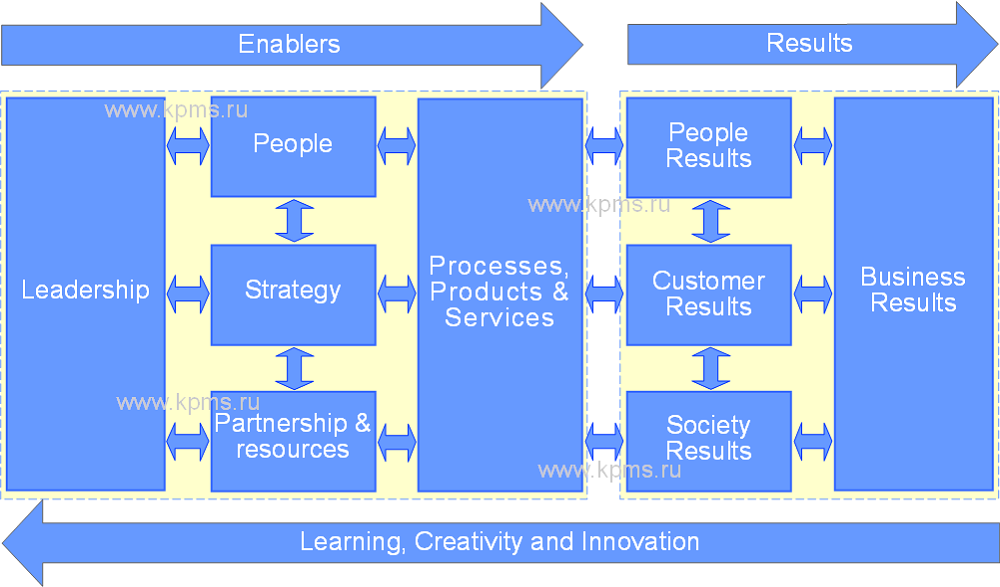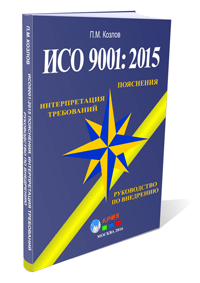The EFQM (European Foundation for Quality Management) model is designed to encourage organizations to improve the quality of products and management. The Foundation was established in 1987 by 14 leading European companies.
The EFQM model
EFQM established the European Quality Award in 1991. The purpose of this award is the help of European organizations to improve their products and management systems and increase their competitiveness in the global market thereby. The name of the quality award was changed in 2006. The new name of the European Quality Award became EFQM Excellence Award. The EFQM Excellence Award is recognition that an organization applies the EFQM model.
Any organization can participate in the EFQM competition. Organization can be located in Europe or abroad.
All participants are divided into 4 categories:
- private commercial organizations;
- public commercial organizations;
- private non-profit organizations;
- public non-profit organizations.
Participants are divided into groups within each category - small and medium-sized organizations, large and very large organizations. The winner, several prize-winners and several finalists of the EFQM Award are determined annually.
The winner is an organization that has achieved exceptional results in all areas of activities, is applying the EFQM model and can demonstrate a highly effective, results and continuously improving management system.
EFQM Award prize-winners are organizations that apply the fundamental EFQM model concepts and have achieved outstanding and sustainable results in one of the following areas:
- increasing value for the customer;
- creating sustainable development;
- development of the organization's capabilities;
- application of creativity and innovation;
- leadership in strategy, promotion and integration;
- managing adaptation to changes;
- development of staff abilities;
- preservation of outstanding results.
Finalists are organizations that can demonstrate a high level of maturity in the implementation of their strategies and have achieved good results according to all criteria of the EFQM model.
The EFQM Excellence Award is based on the criteria that the EFQM model contains. Organization must submit an application to the award committee, conduct a self-assessment according to the criteria of the EFQM model and present a report in order to participate in the competition. The committee's experts evaluate and select the organizations that have scored the highest number of points. Onsite check is carried out of the selected organizations after that. The best of them becomes the winner (sometimes there are no winners). The other organizations become prize-winners or finalists (depending on the number of points scored).
The EFQM Excellence Award includes nine criteria, each of them contains a number of sub-criteria. The top-level criteria are divided into two groups «opportunities» (include 5 criteria) and «results» (include 4 criteria).
The criteria of the «opportunities» group show what an organization can do and what it is doing in matters of improving its activities. The criteria of the «results» group show the real organization achievements.
The EFQM model criteria are shown on the figure.

The «opportunities» group criteria include:
1. Leadership. This criterion shows how top managers shape the future state of the organization, demonstrate the management flexibility and the ability to quickly respond to changing business environment conditions.
The criterion consists of five sub-criteria:
1 a. Mission, vision, values, moral principles, significance of the EFQM model.
1 b. Development and application of the management system.
1 c. Interaction with customers, partners and society.
1 d. Internal interactions, motivation and efforts to develop a model of improvement.
1 e. Identification and commitment to organizational change.
2. Strategy. The criterion shows how the mission and vision take into account the interests of all stakeholders. Evaluation by this criterion allows to understand how the organization's development strategy is implemented through policies, plans, goals and processes.
This criterion consists of four sub-criteria:
2 a. Current/future needs of stakeholders.
2 b. Execution, measurement, research and study.
2 c. Development, analysis and revision.
2 d. Relationship and deployment key processes.
3. People. The personnel are one of the main values of the organization. This criterion evaluates the ability to achieve the organization and personnel goals on a mutually beneficial basis. The EFQM model takes into account the organization's ability to reward and recognize the staff advantages, motivate employees, create conditions for the development of skills and abilities and use these abilities for the organization benefit.
The criterion consists of five sub-criteria:
3 a. Planning, management and improvement of human resources.
3 b. Knowledge and competencies.
3 c. Engagement and trust.
3 d. Two-way interaction.
3 e. Reward, recognition and care.
4. Partnership and resources. This criterion evaluates how the organization plans interaction and manages external partners, suppliers and internal resources. It is considered how these actions ensure the implementation of strategies, policies and effective execution of processes.
The criterion consists of five sub-criteria:
4 a. External partners.
4 b. Financial resources.
4 c. Buildings, equipment and materials.
4 d. Technologies.
4 e. Information and knowledge.
5. Processes, products and services. This criterion evaluates the ability of an organization to develop, manage and improve processes, products and services. These actions should give to increased value for consumers and other stakeholders. These actions should increase value for customers and other stakeholders.
The criterion includes five sub-criteria:
5 a. Development and management.
5 b. Process improvement.
5 c. Design and development.
5 d. Production, delivery and service.
5 e. Customers.
The «results» group criteria include:
6. Customers results. This criterion evaluates the ability of an organization to achieve outstanding results for current needs of customer's satisfaction and anticipating their future needs.
The criterion consists of two sub-criteria:
6 a. Performance indicators.
6 b. Customer perception measuring.
7. People results. The EFQM model evaluates how an organization achieves outstanding results for current and future needs of employee's satisfaction.
The criterion includes two sub-criteria:
7 a. Performance indicators.
7 b. Employee's perception measuring.
8. Society results. This criterion evaluates how the organization achieves outstanding results for current and future needs of society and other stakeholders.
The criterion includes two sub-criteria:
8 a. Performance indicators.
8 b. Society perception measuring.
9. Business results. It evaluates how the organization achieves outstanding results for current and future needs of the business environment.
The criterion includes two sub-criteria:
9 a. Activity performance indicators.
9 b. Result performance indicators.
A certain number of points are assigned for each criterion. The experts of the EFQM Excellence Award Committee evaluate the reports of organizations and select applicants for the award. The total number of points for all criteria is 500 points.
More detailed information for the EFQM model and the EFQM Excellence Award can be found on the EFQM website.
